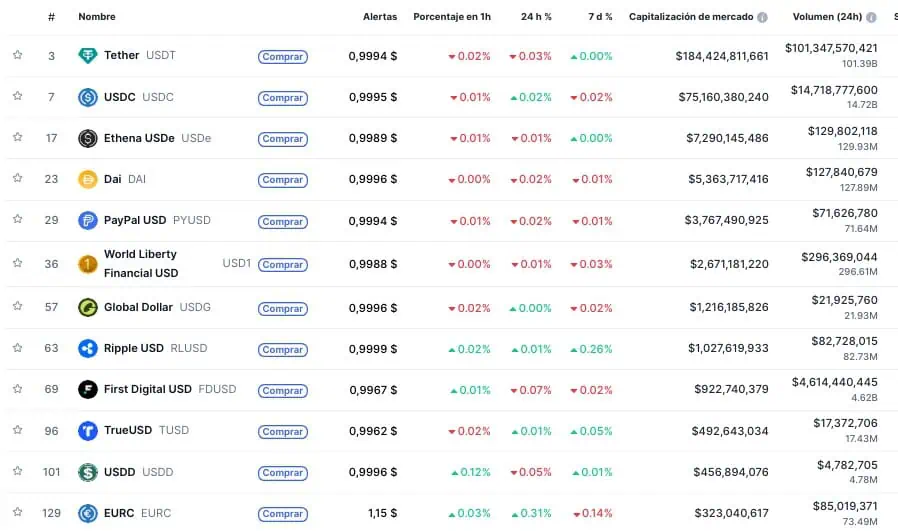
The European Central Bank is warning about the record growth of stablecoins. With a market capitalization of over $300.000 billion, global regulation is urgently needed to prevent potential systemic risks.
The meteoric rise of stablecoins has ceased to be a curiosity of the technological niche and has become a significant variable in the equation of international financial stability.
According to a recent analysis by specialists Senne Aerts, Claudia Lambert and Elisa Reinhold of the European Central Bank (ECB), the market capitalization of these assets has surpassed the $300.000 billion markAlthough this figure represents a milestone of maturity for the crypto sector, it also raises alarms in Frankfurt about the risks of contagion to the traditional economy if coordinated control mechanisms are not established globally.
The report highlights an undeniable reality: the market has grown to a point where its interconnection with traditional finance is profound and tangible. Far from operating in an isolated bubble, the issuers of the main stablecoins have transformed into systemic players managing asset reserves comparable to those of the largest funds in the global money market. This new dynamic suggests that a crisis of confidence in the digital ecosystem would no longer be contained within the blockchain, but could trigger shockwaves in sovereign debt markets and commercial bank balance sheets.
Create your Bit2Me account and access stablecoinsThe hidden danger behind the hegemony of the digital dollar
La radiography The market analysis presented by the ECB reveals the absolute hegemony of the US dollar. Despite European efforts to promote regulated digital assets under the MiCA framework, Euro-denominated stablecoins barely total around $400 millionThis is a negligible fraction compared to the 99% of the circulating supply that is pegged to the US dollar. Two giants, Tether (USDT) and USD Coin (USDC), control almost 90% of this market, with a combined market capitalization exceeding $260.000 billion.
This massive concentration in just two private entities creates a critical structural vulnerability. The issuers of these coins back their tokens with reserves comprised primarily of US Treasury bonds. In recent months, these companies have positioned themselves among the largest net buyers of short-term US debt. Therefore, according to the ECB, the risk lies in the possibility of a digital bank run: if investors were to lose faith in the currency's parity and simultaneously request massive redemptions, the issuers would be forced to liquidate their bond reserves suddenly.
A forced sale of this magnitude would not only sink the value of the cryptocurrency, but could also disrupt the functioning of the US Treasury markets, affecting liquidity and abruptly raising yields.
The ECB emphasizes that this contagion scenario is a real possibility if the sector's growth continues on its current trajectory, with projections placing market capitalization at two trillion dollars by 2028. The main function of these stable digital assets remains to fuel cryptocurrency trading—representing 80% of transactions on centralized platforms—which links the health of reserve assets directly to the volatility of the crypto market.

Source: CoinMarketCap
Stablecoins could transform the deposit ecosystem in the eurozone
Beyond the bond markets, the ECB's analysis focuses on how this phenomenon could alter the funding structure of eurozone banks. The concern lies in the potential replacement of bank deposits with stablecoin holdings. In other words, if households and businesses were to begin perceiving these digital assets as a more viable alternative for storing value, Commercial banks could suffer a retail capital outflow.
Customer deposits have traditionally been the most stable and cost-effective source of funding for banks. Losing this base would force banks to rely more heavily on wholesale or market funding, which is historically more expensive and volatile. Although the European MiCA regulation explicitly prohibits issuers from paying interest to users for holding stablecoins—a measure designed precisely to prevent them from unfairly competing with savings accounts—the risk of disintermediation persists if technological adoption accelerates through other means.
The report clarifies that, in the current scenario, the money leaving retail deposits could return to the banking system as wholesale deposits made by the stablecoin issuers themselves, who need to safeguard their liquidity. However, this return of capital does not solve the underlying problem: the deposits of a crypto giant are far more prone to sudden withdrawals than the savings of thousands of small customers, leaving banks exposed to more severe liquidity shocks during periods of financial stress.
Join Bit2Me and trade regulated crypto assetsEurope calls for international cooperation to protect investors
The entry into force of Cryptoasset Markets Regulation (MiCA) This has placed the European Union at the forefront of legal certainty, offering a clear framework for the issuance and supervision of these assets. However, the digital nature of money does not respect physical borders. Therefore, the ECB warns that the existence of disparate regulations in other jurisdictions, such as the United States with its recent GENIUS Act or the new laws in Hong Kong, creates opportunities for regulatory arbitrage.
The risk of regulatory "leakage," according to the bank, is clear. An entity could issue a global stablecoin by taking advantage of the more lenient regulations of a third country to operate in international markets, introducing risks that would escape European supervision but would affect investors in the region. The report's authors conclude that the only effective defense against a $300.000 billion market is... international development.
Aligning regulatory frameworks with the G20 roadmap and the Financial Stability Board's (FSB) recommendations is not an option, but an essential requirement. The unstoppable growth of stablecoins means that the strength of the global financial system depends on the ability of its regulators to close the gaps that could become the root of future crises.
It operates with stablecoins under the MiCA Act

